(Reminder: almost all screenshots are clickable to expand them to full size.)
In 1936, the fledgling Republic of China led by the Kuomintang has reached an uneasy truce with the other Chinese factions. Following the Long March, Mao Zedong’s Communist forces has retreated to the interior of Shaanxi. Many parts of China are under the rule of warlords including Shaanxi itself to the north, Yunnan to the east and to the south the most powerful of all the warlords, the Guangxi Clique. To the northwest are the Xibei San Ma clique, composed of Muslim Hui Chinese warlords, but they are our puppets and do our bidding.
The reason for this detente of course is the Japanese threat in the north. The Japanese had invaded Manchuria in 1931 and formed the puppet state of Manchukuo. The Chinese are all too aware that the Japanese will not stop there and intends to conquer all of China for its resources. The common people urge an end to the civil war and for all parties to present a united front against the Japanese. But as the Nationalists, we will have none of this. As Chiang Kai-shek has stated, the Japanese are a disease of the skin, but the Communists are a disease of the heart. We are confident that a united China under the leadership of the KMT would be more than strong enough to fend off the foreigners.
Our plan is therefore to aggressively prosecute a renewed war against the Communists as soon as is feasible while building up a strong force to hold back the Japanese. Then we will move to eliminate the warlords one by one until China is unified. We must also take care to annex the territories of Tibet, Sinkiang and Mongolia before they fall under the umbrella of the USSR. After that, we will push the Japanese off the mainland and hopefully will eventually be strong enough to invade their native islands.
In 1936, the nominal head of the state is the widely respected Lin Sen but he is a mere figurehead. Actual power is held by Chiang Kai-shek who both runs the government and is the commander in chief of the military. Our ministers are all generally quite good, helping us to reduce supply consumption by our forces, reduce the consumption of Consumer Goods and to allow our forces to both regain organization faster after combat and to be able to be redeployed more quickly after they have been in combat. Only minor adjustments are needed here. It is better to have a bit of dissent than to have a corrupt minister who steals our production.
For now, we will keep our military as a Volunteer Army to help save money. It will take some time before we are ready for war. We maintain high spending in education to cultivate the many talented people that China will need if we are to become a major power. We also spend the most time possible training our military recruits as we should have more than enough industrial capacity to bulk up on our forces before Japan invades. Once the war actually starts, we will change this to trade quality for quantity.
Finally, we note that the Kuomintang is the most powerful political force in the lands we control by a fair margin. As we do not hold elections, popularity is not a major concern, but we will be wise to invest enough in Consumer Goods so as to minimize dissent and maximize popularity all the same.
Next, we review the military forces at our disposal. We have a solid number of footsoldiers, in the form of infantry, militia and garrison units. However our divisions are organized badly in binary formations of two brigades per division. As we intend to assault the Communists as soon as possible and will want to form a frontline against the Japanese, we send all of our infantry to the north, reorganizing them into more effective triangle divisions of three brigades each when they arrive. Eventually we will want each division to have an artillery brigade to back them up, so that is expensive and so we do without for now.
Our militia units will be used as a secondary line of defense in case the frontline collapses and to act as a reaction force against enemy assaults. Garrison units will be used to secure critical cities and ports. Strategic redeployment orders go out to all units immediately, though it will take weeks before all units arrive at the positions they are assigned. Other than this, we have no other land assets. No tanks, no motorized or mechanized infantry, not even cavalry. We are a very slow-moving force.
Apart from this, we have a small flotilla of naval units, including light cruisers, destroyers and a transport unit. But we cannot expect these to be a match for the Japanese Navy and they will likely have to stay in port for much of the time. We also have a wing of World War I-era interceptors and a wing of tactical bombers. While they might be useful against the Chinese warlords, they will be shredded upon first contact with the Japanese forces.
Most distressingly, we also discover that our soldiers appear to be unarmed. It is a wonder why the Communists fled from us. Naturally, properly equipping our troops will the top priority.
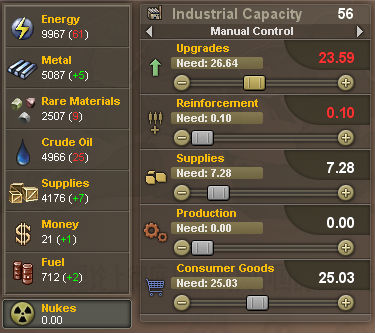
This screen shows us what the combined might of our industry is doing. As you can see, between producing consumer goods to keep our population happy and supplies to maintain our military, we do not have sufficient capacity to even upgrade the equipment of our soldiers at full speed, let alone produce any new units. We will not be able to make anything until after all of our units have the proper equipment to let them do their jobs.
Worse still, this shows us that our economy is currently operating in the red. We simply do not have sufficient resources to sustain our economy. Coal, in particular, is critically short and we are rapidly running down our stockpile. Once we integrate the other Chinese territories into our own government, the situation will improve but we will never be self-sufficient in resources. Therefore, we must trade for the resources we need. Once our economy settles down, we will produce more supplies than we need and export them, so that we can afford to import the resources we lack. Our primary trading partner will be the United States. All hail China, workshop of the world!
Finally, as much as we would like to attack the Communists, we cannot do so at will. The people would object to an unprovoked outbreak of hostilities. In order to declare war, we must lower our own neutrality and increase the perceived threat of the Communists. Therefore, we devote virtually all of our leadership to building spy networks within our nation and inside the territories controlled by the Communists and Yunnan, who we will attack next. They will spread propaganda playing up the threat of these rogue states and convince the general public that conquering them is in China’s best interests. A bare trickle of leadership is used to generate diplomats which we need to arrange trade deals to balance our resource consumption. But for now, we neither conduct any research nor train any new officers. This is a dangerous gamble, but we are confident that it will pay off handsomely in the long run.
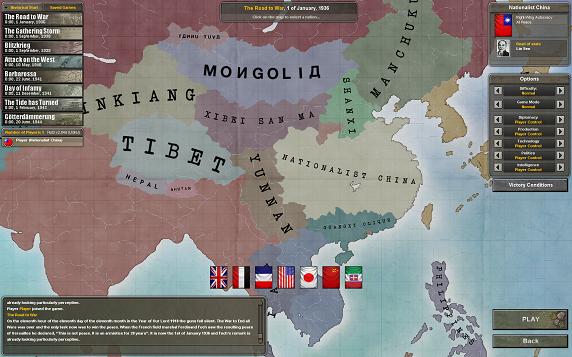
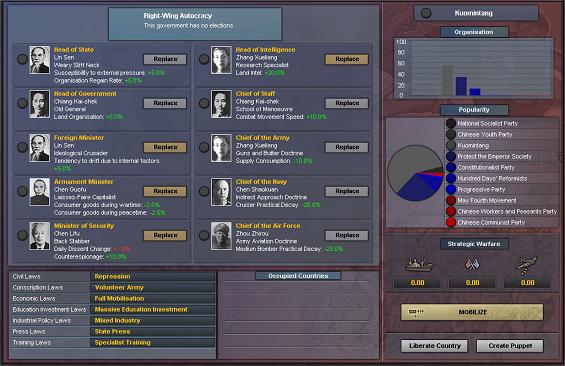
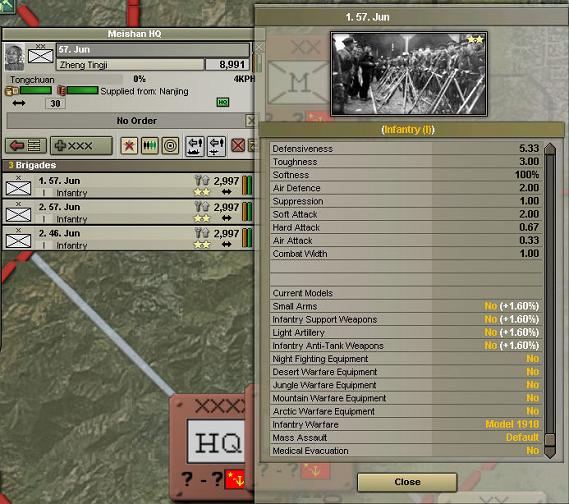
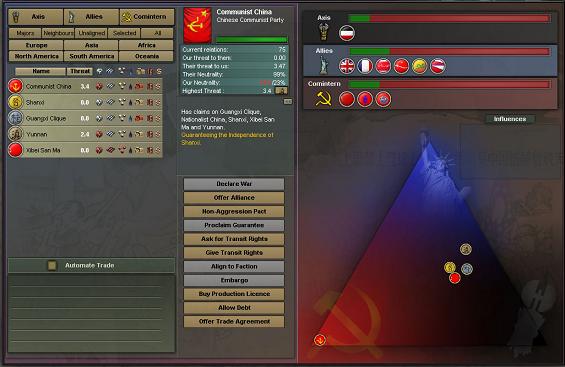
2 Responses to “A Nationalist China AAR – HOI 3 (Part 1)”
Cool. Looking forward to war time. Any infantry will do well with the mountainous regions around China. But the Japs will use armoured divisions.
Will they really use armor? Because that changes things considerably. I thought they would use tons of infantry, plus overwhelming airpower. If they deploy armor in any significant numbers, I am probably screwed.
Leave a Reply